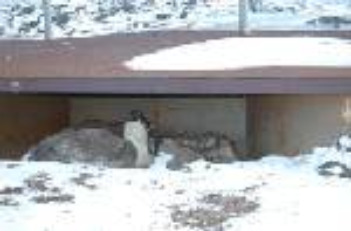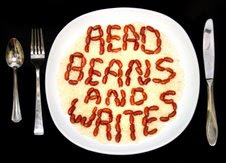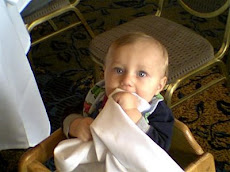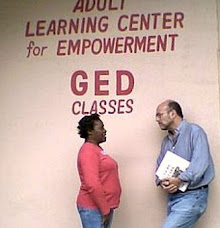
Wednesday, July 30, 2008
Student Sharon Kenney Discusses World War 2

Tuesday, July 29, 2008
The Dome at the South Pole Station
+from+leah.JPG) This is not the Superdome in New Orleans. Bono and U2 did not perform here; the Superbowl was not held here. This is its distant cousin, the dome at the Amundsen-Scott South Pole Station. Leah Webster, a pen pal of our school's from the USAP, sends us this extraordinary photo. The sun is not shining presently at the Pole, but when it was it would always sit low in the sky. As you can see, everything is covered with ice and snow. The snow is probably very old as Antarctica is basically a frozen desert, and it snows infrequently ... but it never melts.
This is not the Superdome in New Orleans. Bono and U2 did not perform here; the Superbowl was not held here. This is its distant cousin, the dome at the Amundsen-Scott South Pole Station. Leah Webster, a pen pal of our school's from the USAP, sends us this extraordinary photo. The sun is not shining presently at the Pole, but when it was it would always sit low in the sky. As you can see, everything is covered with ice and snow. The snow is probably very old as Antarctica is basically a frozen desert, and it snows infrequently ... but it never melts.You can see why the electricians, like our pen pal John Miller, are so important as are the people responsible for the food supply, like Leah. It is not merely a matter of being comfortable, people's lives depend on these things and the people who work with these things. With the completion of the Elevated Station, seen in other photos on this blog, the dome is now a supply base; no one lives there now.
+from+leah+webster+south+pole.jpg) The inside of the dome is used to store food supplies and other necessities that can remain frozen. Thanks, Leah, for another great photo. You have opened our students' eyes to a whole new world!
The inside of the dome is used to store food supplies and other necessities that can remain frozen. Thanks, Leah, for another great photo. You have opened our students' eyes to a whole new world! -- Adrian
Let There Be Light at the South Pole

Monday, July 28, 2008
The Pitot House on Bayou St. John
 Here is another photo interlude from our regular series on Antarctica, Remember Katrina, WW2 Studies, and SVDP-ALC Updates. We do this from time to time so our blog readers and our Antarctica pen pals can get an idea of what some of New Orleans looks like (the part that was not destroyed by the storm).
Here is another photo interlude from our regular series on Antarctica, Remember Katrina, WW2 Studies, and SVDP-ALC Updates. We do this from time to time so our blog readers and our Antarctica pen pals can get an idea of what some of New Orleans looks like (the part that was not destroyed by the storm).This is the Pitot House on Bayou St. John which dates from the early 1800's. It was the original home of the first mayor of New Orleans; now it is a small museum.
-- Adrian
Old U.S. Mint in the Vieux Carre'
 Here is a brief interlude from our regular projects to view a scene from the Vieux Carre' in Old New Orleans. The Vieux Carre', the old quarter also known as The French Quarter, is the oldest part of New Orleans. There you will find some of the most interesting places in the U.S.A., maybe in the world. Here is a photo of the Old U.S. Mint which is now a museum. At present it is housing an exhibit on the treasures of Napoleon Bonaparte, who is, after all, a New Orleans favorite. Legend has it that the pirate Jean Lafitte had intended to rescue Napoleon from his imprisonment on the Isle of St. Helena and spirit him away from the hands of the British to ... where else.. the French Quarter in New Orleans. But Napoleon died on St. Helena before this could occur. His death mask is in the Cabildo, a museum near Jackson Square and the St. Louis Cathedral in the Quarter. There is a street named after Napoleon in New Orleans plus several streets on the streetcar line Uptown are named after famous Napoleonic battles. And since there is a French pastry named "the Napoleon," Bonaparte was bound to be popular in this city.
Here is a brief interlude from our regular projects to view a scene from the Vieux Carre' in Old New Orleans. The Vieux Carre', the old quarter also known as The French Quarter, is the oldest part of New Orleans. There you will find some of the most interesting places in the U.S.A., maybe in the world. Here is a photo of the Old U.S. Mint which is now a museum. At present it is housing an exhibit on the treasures of Napoleon Bonaparte, who is, after all, a New Orleans favorite. Legend has it that the pirate Jean Lafitte had intended to rescue Napoleon from his imprisonment on the Isle of St. Helena and spirit him away from the hands of the British to ... where else.. the French Quarter in New Orleans. But Napoleon died on St. Helena before this could occur. His death mask is in the Cabildo, a museum near Jackson Square and the St. Louis Cathedral in the Quarter. There is a street named after Napoleon in New Orleans plus several streets on the streetcar line Uptown are named after famous Napoleonic battles. And since there is a French pastry named "the Napoleon," Bonaparte was bound to be popular in this city.-- Adrian
Sunday, July 27, 2008
Webcam Links for USAP, South Pole and McMurdo
http://www.usap.gov/videoClipsAndMaps/spwebcam.cfm
This is the link to the webcam for the Amundsen-Scott South Pole Station. Due to extreme weather conditions, the webcam is sometimes down; but there is still an amazing video at the link of the Aurora Australis, the Southern Lights. Be sure to click in and see this.
http://www.usap.gov/videoClipsAndMaps/mcmwebcam.cfm
And this is the webcam for McMurdo Station, the U.S. seabase in Antarctica. It is the largest "settlement" on the Ice.
Be sure to visit these links and the home site for www.usap.gov to read about the organization our Antarctica pen pals are with -- the United States Antarctic Program (USAP).
-- Adrian
Patti Muggivan, teacher, librarian -- Our First Guest Writer
Literacy and New Orleans
By Patti Muggivan
Every time I find myself in New Orleans proper, I am intrigued by its beauty and the easy-appearing nature of the city. But I have always been aware that that environment is deceiving. I think that New Orleans is riddled with crime and people living desperate lives. For me, literacy at all levels is essential for recovery [after the storm]. Literacy was important both pre-Katrina and post-Katrina. Reconstructing entire neighborhoods, with various demolitions and rebuildings, is very difficult. But so too is developing positive attitudes about teaching skills and learning skills. It must be done one person at a time. Improvements in law and government programs are also important.
I was watching the TV news the other day, and there was a story about Darfur and Sudan. I wanted to change the channel. It was so awful seeing a dying child. As I watched, a doctor being interviewed in the news story was saying, "When you ask Americans about the situation, they will say we didn't know. Two years from now they will say the same thing, and conditions will remain unchanged." But if there can be even a chance for Darfur and Sudan, then surely there must be a chance for New Orleans.
(Yes, that's quite a powerful comparison. And in both cases, the real issue, as the doctor implied, is neglect. By ignoring the problems -- both in Darfur and in New Orleans -- the problems only get worse. -- Adrian)
Saturday, July 26, 2008
Remember Hurricane Katrina, August 29th, 2005

Thursday, July 24, 2008
In the News: SVDP-ALC, USAP Pen Pals

Wednesday, July 23, 2008
Canal St. Streetcar in New Orleans

The Canal St. Streetcar, New Orleans

Monday, July 21, 2008
Jason McDonald on the Ice

Jason McDonald of the USAP sends us this cool photo of himself "on the ice." (In Antarctica, the expression "on the Ice" means being in Antarctica.) Double click the photo to enlarge to see how vaste the ice really is.
Jason has a lot in common with us in New Orleans. He was born in Baton Rouge -- must be an LSU Tigers fan -- and has even lived in New Orleans as have several members of his family. He understood the terrible events of Hurricane Katrina as well because of his connections to the Big Easy and Louisiana.
So, he can really understand the similarities and differences between us and the people "on the Ice." But though we live in different places, we have common dreams. Jason and the other Antarctica pen pals are really helping our students to learn a lot. It's a great education! Thanks for the emails and the great photo, Jason.
--Adrian
Sunday, July 20, 2008
Miss Doretha's World Famous New Orleans Gumbo Recipe !!

Saturday, July 19, 2008
Sharon Kenney Studying World War 2 History

Studying World War Two at SVDP-ALC

A frozen lake in Antarctica

Shandra Cordovano at a Frozen Lake Near McMurdo

Thursday, July 17, 2008
Sr. Kathleen Bahlinger has arrived at SVDP-ALC

Planet Mars, Antarctica, New Orleans

Wednesday, July 16, 2008
Mid-Winter, South Pole Station, Antarctica

Tuesday, July 15, 2008
Student Writing: "Myself and Antarctica" By Jennie Gorden

Sunday, July 13, 2008
Oiling Eggs at the Amundsen-Scott South Pole Station
+south+pole.jpg)
Calee Allen also sent us this amazing photo. What are the USAP members doing with the eggs at the South Pole? They are all in the station's galley putting oil on the eggs to preserve them. The oil makes an airtight coating which protects the eggs from the air which can make the eggs go bad. Eggs can last awhile, but eventually they become sour. There are no grocery stores around, of course; and the eggs must be preserved to last the long Antarctic "winter."
-- Adrian
Calee Allen at the New Station, South Pole
+calee+allen+south+pole.jpg)
Here is Calee Allen in front of the New Station (which is also called the Elevated Station) at the South Pole. She lives and works at the Amundsen-Scott base and has sent our school some spectacular photographs. Here is one of them. The Elevated Station is on stilts which can move the station up and down to compensate for the build-up of snow and ice which would otherwise block the entrance to the station. When the station is raised, the strong winds blow the snow away from under the station. Very ingenious. We could use some buildings that rise in New Orlease to avoid flooding, like in Katrina. --Adrian
Saturday, July 12, 2008
South Pole Electricians, John Miller, pen pal... and Satchmo

Images from the South Pole, Antarctica
 The photo at left is from our pen pal John Miller. This is the way back to the Amundsen-Scott South Pole Station. Can you just imagine having to travel this way? John, an electrician at the Pole who has the big responsibility of keeping the power on at the station, relates to us that the weather is sometimes -90 degrees Fahrenheit, with a wind chill of -130 F. (By contrast, it was about 94 degrees Fahrenheit in New Orleans today too, but that was 94 ABOVE zero.) Also remember, because Antarctica is in the southern hemisphere, everything is backwards on the seasons. Here in New Orleans it is terribly hot and humid in the summer. But June, July, and August are "winter" months at the Pole, with endless days of extreme cold and darkness as the sun stays set for many months. I recommend a nice cup of hot chocolate when you get back to the station! Many a bowl of steaming, hot seafood gumbo too.
The photo at left is from our pen pal John Miller. This is the way back to the Amundsen-Scott South Pole Station. Can you just imagine having to travel this way? John, an electrician at the Pole who has the big responsibility of keeping the power on at the station, relates to us that the weather is sometimes -90 degrees Fahrenheit, with a wind chill of -130 F. (By contrast, it was about 94 degrees Fahrenheit in New Orleans today too, but that was 94 ABOVE zero.) Also remember, because Antarctica is in the southern hemisphere, everything is backwards on the seasons. Here in New Orleans it is terribly hot and humid in the summer. But June, July, and August are "winter" months at the Pole, with endless days of extreme cold and darkness as the sun stays set for many months. I recommend a nice cup of hot chocolate when you get back to the station! Many a bowl of steaming, hot seafood gumbo too.--Adrian
Tuesday, July 8, 2008
South Pole Station -- John Miller, First Contact From Antarctica

Saturday, July 5, 2008
South Pole Amundsen Scott Station and Leah's Cake

Here are two more great photos sent to us from USAP member Leah Webster at the South Pole. The new Elevated Station is at left where our friends live. The amazing colors in the sky are the Aurora Australis. We can also see some other buildings in the photo and the Antarctic sun which sits low on the horizon.
At right is Leah Webster herself with the cake she baked. It looks just great, and our students call it a South Pole King Cake because it looks like the King Cakes we eat in New Orleans for Carnival Time. All Leah would really need to do to make this look like a New Orleans cake is to add sprinkled sugar on top in three colors -- purple, green, and gold which are the colors of the New Orleans Mardi Gras. But the students love the cake the way it is in the photo. It looks delicious!
From what we understand, baking cakes is very difficult at the Pole because of the high altitude and other extreme conditions.

This photo of Leah and her cake is one of the most popular photos with our students.
(People from New Orleans love to talk about food and cooking.)
Thanks, Leah, for the great photos!
-- Adrian
We Remember Hurricane Katrina

This is a satellite photo from the NASA website of Hurricane Katrina in late August, 2005. As you can see the storm takes up most of the Gulf of Mexico as it takes aim at the city of New Orleans and the Gulf Coast. Three years ago on August 29th, 2005, this monster hurricane smashed its way ashore with its eye about 25 miles east of New Orleans.
But it was almost a day later when the real horror began in New Orleans. The levees for the outfall, drainage canals -- the London Canal, the Industrial Canal, and the 17th Street Canal -- suddenly broke, and a tremendous flood occurred putting 80% of the city of New Orleans underwater. About 2,000 people died in Hurricane Katrina. The entire population of the city -- over 400,000 people -- were forced to evacuate, many to distant, unfamiliar cities and states. Some of them later died from illness, trauma, or other hardships; and many of the ones who survived still have not returned home. And all of them suffered either physically or emotionally.
Much of the city -- in neighborhoods like Gentilly, New Orleans East, Broadmoor, Lakeview, the Ninth Ward, and the Lower Ninth Ward -- is still, to this day, left in ruins. Houses remain destroyed and abandoned, and lives torn around and wrecked.
Hurricane Katrina was the worst disaster -- in terms of cost-- in American history.
All of the students, teachers, and volunteers at SVDP-ALC endured this nightmare, directly or indirectly. Hurricane Katrina is one reason why our school takes the topics of science and mathematics seriously; and why we are glad to have pen pals in the USAP in Antarctica who support, directly or indirectly, the study of weather conditions on our planet and the increasingly crucial study of climate change.
Our school blog will be having many more posts, and hopefully writings from our students, about the hurricane as we approach the third anniversary of that horrible day.
-- Adrian
Tuesday, July 1, 2008
South Pole Station and Aurora Australis





















